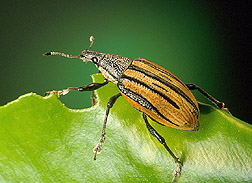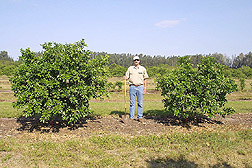Better Rootstocks for Sturdier Citrus |
|
 Adult citrus root weevil, Diaprepes abbreviatus. (K7456-1) |
Since the 1890s, ARS has been developing rootstocks—the bottom portions of grafted trees— for the U.S. citrus industry. In recent years the industry has become concerned with several growing threats to citrus rootstocks. Among these are citrus tristeza virus (CTV), citrus root weevil (Diaprepes abbreviatus), foot rot (Phytophthora nicotianae), root rot (P. palmivora), and citrus blight as well as declines related to poor soil adaptation and salinity. The two Phytophthora species—which have a very wide host range—and Diaprepes form a lethal combination that is spreading throughout Florida with devastating effects on the state's $8 billion annual citrus industry. Kim D. Bowman, a geneticist at ARS's Horticultural Research Laboratory in Fort Pierce, Florida, leads a research program on citrus rootstock breeding and genetics. He and a variety of collaborators are working to solve these underground problems. |
 Grapefruit trees on US-802 (left) and US-897 (right) rootstocks growing in a grove severely infested with Diaprepes weevil and the fungi Phytophthora nicotianae and P. palmivora. The two trees with tolerant rootstocks appear to be healthy, while neighboring trees on common commercial rootstocks are declining. Robert Adair, Jr., director of the Kerr Center for Sustainable Agriculture, a cooperator in the ARS-led citrus rootstock study, stands between the trees to give a sense of scale. (K10883-1) |
Three new rootstocks—US-897, US-942, and US-802—have emerged from Fort Pierce as very strong candidates for eventual commercial use. They have performed well in initial tests for combating a combination of CTV, P. nicotianae, P. palmivora, and the citrus root weevil in heavy (damp) coastal soil. That's a first. They've also demonstrated adaptability to a wide range of soils, good resistance to some other diseases, and favorable effects on fruit productivity and quality. "These three represent the most advanced of thousands of different rootstock selections and hundreds of rootstocks already in field trials," says Bowman. But all three of them are still about 3 to 4 years away from being commercialized. A quality rootstock can defend itself against destructive pests while producing a high yield of quality fruit for sometimes up to 50 years. Disease-resistant, healthy rootstocks can be spliced to mature tops (or "scions") that produce the highest quality fruit. These grafted trees live longer and produce citrus fruits sooner than seedling trees. A major difference among the three candidate rootstocks is the effect they have on tree size. Sweet orange trees 12 to 15 years old on US-897 rootstock remain small, perhaps only 10 feet tall; trees on US-942 rootstock will be medium-sized; and trees on US-802 rootstock can exceed 20 feet. Rootstock influence on tree size is a key factor because shorter, more compact trees are easier to manage and harvest. Taller trees can be very productive, but they cost more to maintain. In 2001, Bowman released the US-812 rootstock, which took longer than 30 years to develop. More than 10,000 trees were propagated on this new rootstock in the first year after release. Current demand for trees on this rootstock far exceeds the supply, Bowman says. It has proven to be outstanding for well-drained soils in central Florida. Recognizing the need for better rootstocks, the Florida Citrus Production Research Advisory Council has provided additional funds to expand Bowman's research over the past 5 years. Industry collaborators provide space for widespread field-testing, while scientist collaborators help test plants for resistance to diseases and pests. Plant breeders, horticulturists, and plant pathologists from the universities of Florida, California-Riverside, Arizona-Yuma, and Puerto Rico are working with Bowman, as are geneticists Raymond J. Schnell, in the ARS Subtropical Horticulture Research Unit in Miami, Florida, and Robert A. Owens, of the ARS Molecular Plant Pathology Laboratory in Beltsville, Maryland.— By Alfredo Flores, Agricultural Research Service Information Staff. This research is part of Plant, Microbial, and Insect Genetic Resistance, Genomics, and Genetic Improvement, an ARS National Program (#301) described on the World Wide Web at www.nps.ars.usda.gov. Kim D. Bowman is with the USDA-ARS Horticultural Research Laboratory, 2001 South Rock Rd., Fort Pierce, FL 34945; phone (772) 462-5920, fax (772) 462-5986. "Better Rootstocks for Sturdier Citrus" was published in the December 2003 issue of Agricultural Research magazine.
|






